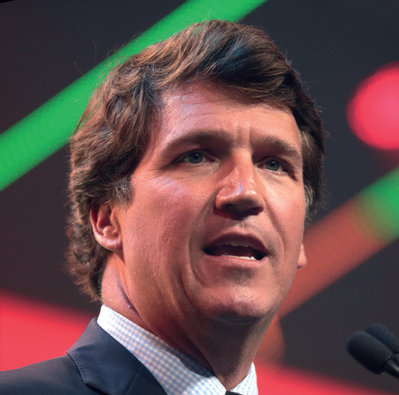Last year’s report contained some positive signs for the news industry, with higher consumption and rising trust amidst a second wave of Coronavirus lockdowns. Many traditional news brands seemed to benefit not just from greater attention, but also financially, with more people taking out online subscriptions and advertisers looking to associate themselves with reliable content.
A year on and we find a slightly less optimistic picture. While a break-out group of primarily upmarket news publishers across the world report record digital subscription numbers and growing revenues, more broadly, we find that interest in news and overall news consumption has declined considerably in many countries while trust has fallen back almost everywhere – though it mostly remains higher than before the Coronavirus crisis began. We’re also seeing news fatigue setting in – not just around COVID-19 but around politics and a range of other subjects – with the number of people actively avoiding news increasing markedly.
Since our main data set was collected in early February, a new threat to global security has emerged in the form of Russia’s invasion of Ukraine. This event clearly increased news consumption across all news sources, but a second Digital News Report survey in five countries undertaken in early April saw further levels of selective avoidance, even in countries like Poland and Germany that have been directly impacted by the conflict. We devote a special chapter to the impact of the Ukraine crisis and attitudes towards media coverage.
An episode on the report
A clear throughline in this year’s report is the changing habits of younger groups, specifically those under 30, whom news organisations often struggle to reach. Throughout this Executive Summary, and in a separate chapter, we find that this group that has grown up with social media is not just different but more different than they were in the past. We also explore their use of newer visual networks for news such as TikTok and Instagram, with support from a detailed qualitative study in three countries (UK, US, and Brazil).
More widely, this year’s data confirm how the various shocks of the last few years, including the Coronavirus pandemic, have further accelerated structural shifts towards a more digital, mobile, and platform-dominated media environment, with further implications for the business models and formats of journalism.
In our country and market pages, which combine industry developments with key local data points, we see how different media companies are coping with these various headwinds. We find a mixed picture of downsizing and layoffs in some places, but optimism around business models, industry cooperation, and format innovation in others. And everywhere we find growing concerns about a looming cost-of-living crisis that could be making people rethink how much they can afford to spend on news media.
This eleventh edition of our Digital News Report, based on data from six continents and 46 markets, aims to cast light on the key issues that face the industry. Our more global sample, which since 2021 has included India, Indonesia, Thailand, Nigeria, Colombia, and Peru, provides some understanding of how differently the news environment operates outside the United States and Europe. The overall story is captured in this Executive Summary, followed by Section 1, with chapters containing additional analysis, and then individual country and market pages in Section 2 with extra data and context.
A summary of some of the most important findings from our 2022 research.
-
Trust in the news has fallen in almost half the countries in our survey, and risen in just seven, partly reversing the gains made at the height of the Coronavirus pandemic. On average, around four in ten of our total sample (42%) say they trust most news most of the time. Finland remains the country with the highest levels of overall trust (69%), while news trust in the USA has fallen by a further three percentage points and remains the lowest (26%) in our survey.
-
Consumption of traditional media, such as TV and print, declined further in the last year in almost all markets (pre-Ukraine invasion), with online and social consumption not making up the gap. While the majority remain very engaged, others are turning away from the news media and in some cases disconnecting from news altogether. Interest in news has fallen sharply across markets, from 63% in 2017 to 51% in 2022.
-
Meanwhile, the proportion of news consumers who say they avoid news, often or sometimes, has increased sharply across countries. This type of selective avoidance has doubled in both Brazil (54%) and the UK (46%) over the last five years, with many respondents saying news has a negative effect on their mood. A significant proportion of younger and less educated people say they avoid news because it can be hard to follow or understand – suggesting that the news media could do much more to simplify language and better explain or contextualise complex stories.
-
In the five countries we surveyed after the war in Ukraine had begun, we find that television news is relied on most heavily – with countries closest to the fighting, such as Germany and Poland, seeing the biggest increases in consumption. Selective news avoidance has, if anything, increased further – likely due to the difficult and depressing nature of the coverage.
-
Global concerns about false and misleading information remain stable this year, ranging from 72% in Kenya and Nigeria to just 32% in Germany and 31% in Austria. People say they have seen more false information about Coronavirus than about politics in most countries, but the situation is reversed in Turkey, Kenya, and the Philippines, amongst others.
-
Despite increases in the proportion paying for online news in a small number of richer countries (Australia, Germany, and Sweden), there are signs that overall growth may be levelling off. Across a basket of 20 countries where payment is widespread, 17% paid for any online news – the same figure as last year. Persuading younger people to pay remains a critical issue for industry, with the average age of a digital news subscriber almost 50.
-
A large proportion of digital subscriptions go to just a few big national brands – reinforcing the winner takes most dynamics that we have reported in the past. But in the United States and Australia we are now seeing the majority of those paying taking out more than one subscription. This reflects the increased supply of differentiated paid news products in areas such as political opinion, local news, and a range of specific niches – holding out hope that more people will ultimately pay for multiple titles.
-
But in the face of rapidly rising household bills, we find some respondents rethink the number of media subscriptions they can afford this year – which include news, television, music, and books. While most say they expect to retain the same number of media subscriptions, others say they expect to take out fewer, as they look to save money on non-essential items.
-
With first-party data collection becoming more important for publishers with the imminent demise of third-party cookies, we find that most consumers are still reluctant to register their email address with news sites. Across our entire sample, only around a third (32%) say they trust news websites to use their personal data responsibly – comparable to online retailers such as Amazon – and the figure is even lower in the United States (18%) and France (19%).
-
Access to news continues to become more distributed. Across all markets, less than a quarter (23%) prefer to start their news journeys with a website or app, down nine points since 2018. Those aged 18–24 have an even weaker connection with websites and apps, preferring to access news via side-door routes such as social media, search, and mobile aggregators.
-
Facebook remains the most-used social network for news but users are more likely to say they see too much news in their feed compared with other networks. While older groups remain loyal to the platform, we show how the youngest generation has switched much of its attention to more visual networks over the last three years.
-
TikTok has become the fastest growing network in this year’s survey, reaching 40% of 18–24s, with 15% using the platform for news. Usage is much higher in parts of Latin America, Asia, and Africa than it is in the United States or Northern Europe. Telegram has also grown significantly in some markets, providing a flexible alternative to Meta-owned WhatsApp.
-
While social media have increased the profile of many digital journalists, we find that the most well-known journalists are still TV anchors and presenters in most countries. When asked to name journalists they pay attention to, few people can name foreign correspondents, while newspaper columnists have higher name recognition in the UK and Finland than in Brazil, the United States, or France.
-
The smartphone has become the dominant way in which most people first access news in the morning, though we find different patterns across countries. In Norway, Spain, Finland, and the UK, the smartphone is now accessed first ahead of television, while radio retains an important role in Ireland. Morning newspaper reading is still surprisingly popular in the Netherlands; television still dominates in Japan.
-
After last year’s slowdown in part caused by restrictions on movement during the COVID-19 pandemic, growth in podcasts seems to have resumed, with 34% consuming one or more podcasts in the last month. Our data show Spotify continuing to gain ground over Apple and Google podcasts in a number of countries and YouTube also benefiting from the popularity of video-led and hybrid podcasts.
Consumption patterns reveal disconnection and disengagement with news – amongst some news consumers
While a succession of crises including the pandemic and the invasion of Ukraine demonstrates the importance of independent professional journalism, and significant growth for some individual media brands, we find that many people are becoming increasingly disconnected from news – with falling interest in many countries, a rise in selective news avoidance, and low trust further underlining the critical challenge news media face today: connecting with people who have access to an unprecedented amount of content online and convincing them that paying attention to news is worth their while.
We now have solid data spanning ten years that enable us to see consistent and relentless falls across countries in the reach of traditional channels such as print, radio, and television news. At the same time, we find that online reach is flat or, at best, increasing slightly – but certainly not making up the gap. Digital and social media offer a much wider range of stories, but this environment can often be overwhelming and confusing. While many people remain extremely active and engaged with online news, the abundance of choice in an online context may be leading others to engage far less regularly than they did in the past.
In the chart below, which shows weekly access in the United States between 2013 and 2022, we have added an extra line for those who say they accessed none of the listed options in the week they completed our survey. This has grown from 3% in 2013 to 15% in 2022.
While the United States seems to have the largest group of disconnected news users, we see similarly high figures in Japan (15%) the United Kingdom (9%), France (8%), and Australia (8%). Even Germany, a country with often very traditional media habits, is not immune. Since 2013, weekly print consumption has fallen from 63% to 26% and TV news usage from 82% to 65%. Although online and social media have grown a little, overtaking television for the first time, we also find growing numbers who seem to be disconnecting from news altogether – this proportion reaching 5% in 2022.
It is important to note that high levels of disconnection are not evident everywhere. The proportion consuming none of our listed news sources weekly is limited in Portugal (2%) and Finland (2%) and extremely rare in South Africa (1%), Nigeria (<1%), and Kenya (<1%), even though we also see growing pressure on traditional sources of news such as print and television news in these countries.
Falling interest in the news
Disconnection is just one sign of the difficulties of engaging some audiences in a more digital environment. At the same time we find that the proportion that says they are very or extremely interested in news has fallen sharply over time across markets – a trend that has accelerated despite the continuing COVID-19 pandemic. This year we find news interest lower in the vast majority of countries in our survey. In some countries, such as Argentina, Brazil, Spain, and the United Kingdom, these falls have been going on for some time, while in the United States we see a slightly different pattern. Interest remained high during the Trump years but seems to have declined significantly since Joe Biden became president. Today, less than half of our sample (47%) say they are very or extremely interested in news compared with 67% in 2015.
Again, it is important to note that there are some countries that buck these trends or where declines are happening more slowly. These include richer Central/Western European nations where there has been less political or economic turmoil over the past few years.
Proportion who are very or extremely interested in news (2015-2022)
Selected countries with largest falls
Selected countries with more stable levels
Q1c. How interested, if at all, would you say you are in news? Base: Total 2015–22 samples (n ≈ 2000).
These data suggest two different but related problems. First, the emergence of a minority of people who are active online, many of them younger or less well educated, but who have become largely disconnected from the news, perhaps because they don’t feel that it is relevant to their lives. And then, separately, we find a more generalised decline in news interest and consumption affecting a much bigger group, which may relate to structural changes in the way the news is distributed, such as the shift to online, the nature of the news cycle itself, or both.
Selective news avoidance and its implications
While the majority of people across countries remain engaged and use the news regularly, we find that many also increasingly choose to ration or limit their exposure to it – or at least to certain types of news. We call this behaviour selective news avoidance and the growth of this activity may help to explain why consumption levels have mostly not increased, despite the uncertain times in which we live. The proportion that says they avoid the news, sometimes or often, has doubled in Brazil (54%) and the UK (46%) since 2017 – and also increased in all other markets (see next chart). This type of selective avoidance seems to be less widespread in Northern European countries such as Germany (29%), Denmark, and Finland (20%), as well as in some Asian countries such as Japan (14%).
Selective news avoiders give a variety of reasons for their behaviour. Across markets, many respondents say they are put off by the repetitiveness of the news agenda – especially around politics and COVID-19 (43%), or that they often feel worn out by the news (29%). A significant proportion say they avoid news because they think it can’t be trusted (29%). Around a third (36%), particularly those who are under 35, say that the news brings down their mood. Others say the news leads to arguments they would rather avoid (17%), or leads to feelings of powerlessness (16%). A small proportion say they don’t have enough time for news (14%) or that it is too hard to understand (8%).
Most common reasons for news avoidance
All markets
-

43%
say there is too much politics and COVID-19
-

36%
say news has negative effect on mood
-

29%
say they are worn out by amount of news
-

29%
say the news is untrustworthy or biased
-

17%
say it leads to arguments I'd rather avoid
-

16%
say there is nothing I can do with the information
Q1di_2017ii. Why do you find yourself actively trying to avoid the news? Base: All who avoid the news often, sometimes, or occasionally. All markets = 64,120.
Concerns about the news having a negative effect on their mood are higher amongst avoiders in the United Kingdom (55%) and United States (49%) than they are elsewhere.
Political allegiances can also make a striking difference to why people choose to avoid news. In the United States, those who self-identify on the right are far more likely to avoid news because they think it is untrustworthy or biased, but those on the left are more likely to feel overwhelmed, carry feelings of powerlessness, or worry that the news might create arguments.
These findings will be particularly challenging for the news industry. Subjects that journalists consider most important, such as political crises, international conflicts, global pandemics, and climate catastrophes, seem to be precisely the ones that are turning some people away from news – especially amongst those who are younger or harder to reach.
Many news organisations are embracing approaches such as solutions journalism around subjects like climate change, that aim to give people a sense of hope or personal agency. Others are looking to find ways to widen the agenda to softer subjects or make news more relevant at a personal level, but there will be a limit to how far journalists can go – or should go – to make the news more palatable.
News is too hard for many people to work out
One other important data point relates to the difficulty that many younger audiences, and less educated groups, have in understanding journalism as currently practised. In countries such as Australia, the United States, and Brazil, around 15% of younger avoiders say they find news hard to follow – a much higher proportion than older news consumers.
This could relate to the complexity of the language or assumed knowledge often contained in news reports. But the increase in news consumption via social media or word of mouth through friends and family, may also be playing a part. News is often accessed by young people in more fragmented ways, meaning that people sometimes miss key context that was previously carefully packaged into linear narratives by the mainstream media.
During the COVID-19 crisis (and now Ukraine) we saw many news organisations using explainer and Question & Answer formats to try to address these issues on websites and via social media to engage younger and less educated audiences. Our data suggest this process needs to go much further.
Trust falls back after COVID-19 bumps
This year we find lower levels of overall trust in 21 of our 46 markets, partly reversing the gains made at the height of the Coronavirus pandemic. Eighteen markets are at a similar level, with just seven on an upward path. The average level of trust (42%) is also a little lower than last year and trust in individual news brands is on a downward trend in most countries.
Finland remains the country with the highest levels of overall trust (69%) – up four points on last year and 13 points on 2020. At the other end of the scale, news trust in the USA (26%) has fallen by a further three percentage points and remains the lowest level in our survey along with Slovakia (26%). Notable changes in Europe include falls in Romania (-9), Croatia (-7), Poland (-6), Switzerland (-5), Austria (-5), Greece (-5), Italy (-5), and Spain (-4). In Latin America, trust is down in Brazil (-6) and Colombia (-3), but level or slightly up elsewhere. It is a mixed picture in Africa, with a fall in Kenya (-4) but strong growth in South Africa (+9) and Nigeria (+4). Finally, in Asia, trust has risen in the Philippines (+5) and Japan (+2) but is down in Malaysia (-5) and Taiwan (-4).
In some regions we find a widening gap between markets with the highest levels of trust and those with the lowest. We also find that those markets with the most trust – such as Finland – also tend to have higher interest in news and lower levels of active news avoidance. By contrast, low trust countries, such as the United States, France, the United Kingdom, and Slovakia, see some of the highest levels of selective avoidance, as well as news disconnection, with declining interest in news.
It is important to put this year’s trust changes in context. In most cases the headline trust level is still higher than it was before the Coronavirus pandemic reinforced the importance of reliable media for many people. On the other hand, the chart below also reminds us that, in many countries, trust had been on a downward trajectory for some time – partly driven by a series of polarising events like Brexit in the UK, the turmoil of the Trump years in the United States, and the Gilets Jaunes protests in France. In this context, last year’s COVID-19 optimism looks more like a short-term rally rather than any kind of longer-term renaissance. In all the examples below, apart from Finland, trust is still considerably lower than in 2015.
Across our data set, and in wider research on this issue (Toff et al. 2021; Ross Arguedas et al. 2022), we find that indifference to news and its value, along with widespread perception of political and other biases by the media, are two of the main reasons for low trust. In the United States, politics is particularly central, and those who self-identify on the right are more than twice as likely to distrust the news compared with those on the left. In early 2021 only 14% of those on the political right said they trusted the news, which helps to explain how the false and misleading ‘stolen election’ narrative promoted by some politicians, activists, and partisan media personalities got so much traction, not least after President Donald Trump’s talk about a liberal mainstream media peddling ‘fake news’. By contrast, in Finland we see almost no difference in news trust based on politics, though even here the cut and thrust of a parliamentary election in late 2019 may have contributed to a slight dip in trust.
In other cases, lack of trust in the news is less about ideological political divides and more about a split between the ‘haves’ and the ‘have-nots’. In France, for example, we find that divisions are more about income and education rather than party allegiance. During the Gilets Jaunes protests, for example, the news media was often seen as aligning itself with the elites, while journalists were also targeted in Canada during trucker protests this year. In both countries, we find significant trust gaps over income or education.
In other parts of the world, lack of trust is closely related to the issue of interference by politicians, businesspeople, or both. This is a particular issue in Central and Eastern Europe where oligarchs close to ruling parties control much of the media, or where governments regularly withhold advertising from publications they don’t like. Only a small minority think the news is free from undue political influence in Greece (7%), Hungary (15%), Bulgaria (15%), Slovakia (16%), Czech Republic (17%), Croatia (18%), and Poland (19%). We see similarly low levels in some Southern European countries, such as Italy (13%) and Spain (13%), where there is also a strong tradition of party-political influence over the media. Compare this with Finland (50%), where people have much higher confidence in the independence of the journalism they see from undue political influence.
It is a similar story when it comes to perceptions of undue business influence, with almost identical scores in most markets. This suggests that consumers either have a clear-eyed view of the connections between politicians and businesspeople, or that they have a more generalised lack of trust about those in power and the relations they have with the news media.
However, a large minority also question the priorities of news organisations themselves. Across all markets, just 19% say all or most news organisations put what’s best for society ahead of their own commercial or political interests. In fact, many more people say that all or most put their own political views (40%) or commercial interests (42%) ahead of society. These views are held by around 20% in countries with high trust in news, such as Finland, but are held by around 45% in the US, the UK, and a majority in parts of Southern Europe, Eastern Europe, and Latin America. This may reflect cynicism about the underlying motivations of many publishers, or perhaps hardened realism about what many commercial news organisations must do to survive. Either way it reminds us that, although people often recognise the pressures they face, few people think that most news organisations fight powerful interests on behalf of society in practice.
Trust in news brands: the particular case of public service media
Underpinning news trust in many Northern and Western European countries, as well as Canada and Australia, we find a number of public service broadcasting organisations with a strong track record of independence. These generally appear at the top of our brand trust lists in each country and are often the first port of call for audiences when looking for reliable news around important stories such as COVID-19 and the Ukraine conflict. These institutions have a very different reputation to public and state broadcasters in Southern and Eastern Europe that often take a more partisan editorial line.
But independent public media are under increasing pressure in a number of countries, with attacks on funding, questions about impartiality, and challenges in reaching younger audiences who are increasingly turning to digital and social media. The BBC faces another round of cuts after a difficult licence settlement while DR, the Danish public broadcaster, recently cut three linear channels as part of a wider restructuring after a narrow parliamentary majority imposed a major cut in funding. Against this background, it is interesting to see how well trust is holding up, with some very notable exceptions. Nordic PSBs as well as those of other smaller countries like Ireland and Portugal have retained or even increased trust since 2018, but it has been a very different story in the UK, Australia, and Canada, with significant falls for the main public broadcasters.
The BBC, which remains the most widely used news source in the UK, reported record audiences in the first weeks of the Ukraine crisis,1 but it has also come under intense criticism for its reporting of a range of more divisive issues – notably Brexit but also immigration, race, gender identity, and attitudes to COVID-19 vaccinations. In many cases, these criticisms of the BBC have been amplified on social media, with senior correspondents exposed to physical attacks along with personal abuse on social media.2
Trust in BBC News has fallen 20 percentage points in the last five years, from 75% to 55%. Equally telling is the proportion who say they distrust the BBC, which has grown from 11% to 26% (see next chart). The majority of these are from the political right, echoing criticism from Boris Johnson’s government about an alleged anti-Brexit and liberal bias, but we also find that low trust in the BBC also comes from those who are less interested in news altogether. It is important to note that other big brands in the UK (e.g. the Guardian and the Mail) have been affected by growing levels of distrust, though not as severely. Declining trust is a particular challenge for public media organisations, as they try to fulfil their mission to appeal to all audiences.
The continued audience success of some European public media makes them a particular target for those who want to influence the debates on politics and wider issues around culture. Our survey shows that journalists from these organisations are often first to be recognised by the public. The outgoing BBC political editor Laura Kuenssberg is by far the most well-known journalist in the UK, according to respondents to our survey, even when it comes to digital news. Broadcasters with a commitment to impartiality, including the BBC, make up 62% of all mentions. Journalists from public media also feature strongly in data from Finland, France, and Germany. But it is a very different story in the United States, where partisan cable TV hosts Tucker Carlson, Rachel Maddow, and Sean Hannity attract the most attention.
-
Best known journalists in Northern/Western Europe have reputation for impartiality

Laura Kuenssberg
BBC Political Editor (outgoing), UKALSO
Marietta Slomka
ZDF TV Anchor, GermanyMatti Rönkä
Yle TV Anchor, Finland -
Best known journalists in USA have reputation for strong opinions

Tucker Carlson
TV Anchor, Fox NewsALSO
Sean Hannity
Fox NewsRachel Maddow
MSNBC
Should journalists remain impartial when on social media?
With more journalists building channels and direct relationships on social media, there is a growing debate about how they should interact when on platforms such as Facebook and Twitter. These are informal spaces where social media users can let their hair down and show more personality. But how compatible is this with the impartial or objective approaches still practised by many media brands (and that last year we found many members of the public value)?
In our survey, around half of respondents or more in most countries feel that journalists should stick to reporting the news, but a sizeable minority believed they should be allowed to express their personal opinions on social media at the same time. Brazil and Japan seem to be outliers here, showing opposite views.
But as we also found in last year’s Digital News Report study on impartiality (Vir 2021), there are clear generational differences, with younger groups holding a stronger preference for journalists being able to express their personal opinions freely on social media. As some media organisations tighten social media guidelines, they are facing resistance from younger journalists who take a different view, and are trying to push the boundaries. This is just another way in which journalistic norms are being challenged by social and digital media.
Paying for news, subscription fatigue, and the battle for registration
In the last few years, many publishers have been increasing efforts to get audiences to pay for content online via subscription, membership, or donations – to reduce their reliance on advertising revenue, which online tends to flow towards the big platforms such as Google and Meta (formerly Facebook). These are now worldwide trends, and our country pages document how leading publishers in Argentina, Colombia, Japan, Nigeria, and Kenya, for example, have recently launched or consolidated paywalls.
This year’s data show mixed progress, with significant increases in a small number of wealthier countries, though there are signs elsewhere that growth may be levelling off. Across a basket of 20 countries where payment is relatively widespread, 17% paid for any online news – the same figure as last year. Norway continues to lead the way (41%), followed by Sweden (33%), Finland (19%), and the United States (19%). Australia (18%) and Germany (14%) showed the biggest increases this year at five percentage points in each case. By contrast, our survey data in Norway and the United States show a slight decline this year, though in both cases industry figures suggest that there has still been some progress. Either way, longer term trends do suggest a slowing down in some of these early-mover markets – raising questions about whether they might be reaching a more mature phase.
This year we asked those paying for online news to name the brands they subscribed to. In some countries, we find a high degree of market concentration, with around half the subscriptions in the US going to the New York Times, Washington Post, and Wall Street Journal. In Finland, half of subscribers (50%) pay for just one publication – Helsingin Sanomat, the country’s paper of record – sometimes in combination with a local publication. Over half (53%) pay for a local or regional title in Norway, with high numbers in all the other Nordic countries as well as Germany (35%) and the United States (27%). By contrast, just 5% of subscribers pay for a local title in the UK and 3% in Portugal.
Another striking finding is that, across countries, the vast majority of those paying are older, with an average age of 47 across countries. Persuading younger people to pay remains a critical issue for industry, with just 8% of news subscribers in the UK being under 30 and just 17% in the United States. This quote from our focus groups sums up the attitude of many of those who grew up in an era with mostly free online sources.
In almost all of the listed countries, the majority of subscribers pay for one publication. But in the United States and Australia, around half (56% and 51% respectively) now pay for two or more – often a national and local paper combination. Second subscriptions in the United States include political and cultural magazines such as The Atlantic and The New Yorker, partisan digital outlets such as Blaze Media and Epoch Times, or passion-based titles such as the Athletic (sports). We also see growing levels of payment for platform-based news subscription products Apple+ and Twitter Blue. In Australia, second subscriptions include a relatively high proportion (9%) from US or UK publications such as the New York Times and The Times of London.
The influence of individual journalist brands may be overstated
Some news brands continue to have the reputation, scale, and technical capability to charge for their services, but in parallel the emergence of low-cost subscription and membership platforms, like Substack and Patreon, has enabled some individual journalists, podcasters, or other creators to also convince people to pay for their work. Substack says that there are now around a million paying subscribers to its premium content emails.3
Despite this, our data show the number of these individual subscriptions is still relatively modest, certainly when compared with established news brands. Even in the United States, we find that just 7% of news subscribers in the United States pay for one or more journalist emails – around 1% of our overall sample. The proportions are even lower elsewhere, though we do see some emerging payment for individual email writers or podcasters in parts of Europe and Australia.
Over time, it is possible that these solo or small businesses, mostly operating in closely defined niches, could make up a far bigger part of the overall pie, expanding the market but also creating more competition for big news brands. If nothing else, they have already made the value of some individual journalists more explicit, pushing up wages of top talent.
These data also highlight the growing importance of formats like email and podcasts, both of which have become much more important in driving regular engagement for all publishers – from general news to specialist information and entertainment.
In the vast majority of markets in our survey, people say they still identify most with traditional news brands rather than individual journalists. This is especially true in Nordic countries but less true in the United States, Southern Europe, Latin America, and parts of Asia. Perhaps the greater affinity with journalists in these countries offers a different opportunity to monetise content than brand-led subscription.
The impact of wider media subscriptions and prospects for subscription fatigue
With rising energy prices and inflation, and with many different types of online media (TV, music, books) now competing for a share of household budgets, there are genuine fears in the industry about whether recent growth in news subscriptions can continue. Against this backdrop, we explored the characteristics of different media subscriptions and asked respondents whether they were thinking of taking out more – or cutting back.
Taking the UK as an example of an advanced subscription market (chart below), we find almost two-thirds of our sample (65%) have taken out at least one subscription to a TV or film service like Netflix, 37% have a music subscription to Spotify or similar, 22% pay for a premium sports service, and 7% have a news subscription or other ongoing payment such as a donation. Because premium content is spread across TV platforms, many people feel the need to take out more than one subscription, with 19% taking out three or more. By contrast, one music or news service is normally enough, as rival services often offer broadly similar content. But as we noted earlier, in some countries we are seeing more differentiated news services and a consequent rise in the number of subscriptions per person. The other big difference is the age profile, with TV, music, and audio books skewing younger, while sport has an equal age split and news skews much older. People who subscribe to news are more likely to subscribe to other services and vice versa.
Thinking about the year ahead, most respondents say the number of media subscriptions they have (across TV, music, sports, books, and news) will stay the same, but there is an appetite to take out more in Germany, Austria, and Switzerland. By contrast, the Portuguese are most likely to be looking to reduce their media subscriptions this year, while respondents in the UK and US are evenly split.
This overall picture is perhaps more optimistic than might be expected, with relatively low subscription churn, providing publishers with a more stable and secure income than the frequent ups and downs of the advertising market. On the other hand, the cost-of-living crisis has been building since our survey in January and will clearly be a significant factor for those on lower incomes.
It’s not entirely clear whether news will be treated in the same bucket as entertainment subscriptions that could be seen as more of a luxury. The news demographic tends to be older and richer, perhaps making the group less affected by rising prices. On the other hand, the sector is unlikely to be immune from these trends and a number of respondents said they would be cancelling subscriptions to news sites because they were too expensive. Others say they are planning to increase the number of subscriptions this year, with some seeing the current national and international instability as a good reason to invest more in high-quality information.
Investment in new products may encourage further take-up and much of the news industry remains confident about longer-term trends. But some publishers, notably CNN, recently reversed its much-hyped online paywall strategy (CNN+) amid doubts from its new owners about the viability of yet another stand-alone subscription.4 Uncertainty remains about how far and fast the market can grow, especially in more troubled economic times.
Audiences reluctant to give up their data for news sites
Beyond concerns about subscription diets, media companies face another challenge in maintaining advertising revenues in the face of the imminent phasing out of third-party cookies.5 Without these cross-platform trackers, media companies are looking to build up their own first-party data that can give them more leverage with advertising companies – and increase the rates they can charge. News companies now routinely ask for an email address before people can see content or access additional features such as commenting. In some countries (Portugal, Finland, and Switzerland), publishers have collaborated to provide a single login system that works across multiple online websites and apps. But how do audiences view these issues?
Across countries we find that only around a quarter (28%) have registered for one or more news websites in the last year. Those in Portugal (44%) are most likely to have given their details, but people in Germany (19%), the UK (16%), and Japan (14%) are least likely to have parted with their information for access. These differences may relate to the extent to which registration walls are being pushed by publishers in each country, but the relatively low levels in general reflect a continuing reluctance amongst consumers to give up email addresses or other personal details – especially if content is available elsewhere. Most news websites simply do not have a clear enough value proposition to persuade people to do so.
We also compared willingness to give data to news sites with other digital services such as online retailers and social media apps. Across our entire sample, only around a third (32%) say they trust news websites to use personal data responsibly – ahead of social media sites (25%), but at a similar level to trust in online retailers (33%). This does vary considerably by country, with 49% of Finns prepared to trust news organisations with data, but only 18% in the United States.
Proportion who trust each to use their data responsibly
All markets
-

Online retailers
33%
Highest in Poland (44%)
Lowest in France (18%)
-

News websites
32%
Highest in Finland (49%)
Lowest in USA (18%)
-

Social media
25%
Less trust in social platforms to use data responsibly
REGISTER2_1/2/3 I trust most news websites/social media sites/online retailers to use my data responsibly. Base: Total sample: All markets = 44,924.
We find a clear link between general trust and people’s willingness to trust publishers with their data. Those with the highest levels of trust (48%) are more than twice as likely to give up their data than those with the lowest (19%). In this respect, building trust will be critical not just for those pursuing subscription models but for any publisher looking to engage and connect with audiences more deeply in the future.
Devices and access points to news
The smartphone continues to be the most important digital device for accessing news across countries, though our data suggest the first decline in weekly access since our survey began – reflecting falling news consumption across all devices after COVID-19 highs.
This year, we revived a question about how different groups access news first thing in the morning to give a sense of how news habits have changed since 2019. The next chart shows striking differences between countries. In Norway, Spain, Finland, and the UK, the smartphone is now the go-to route to news in the morning, with dependence on it growing substantially in the last three years. Radio remains an important part of morning routines in Ireland – even though it has been overtaken by the smartphone for the first time. Morning newspaper reading is still surprisingly popular in the Netherlands and Finland. Television remains a key influence in the US, France, and Italy and is the dominant medium in Japan.
Across countries, almost half of under 35s (47%) say they accessed news first using a smartphone, compared with just a quarter (28%) of those aged 35 and older and just 15% of those aged 65 and older. Japan’s older population may explain why it is bucking wider trends.
But what channels do people use when accessing news on a smartphone at the start of each day? Since 2019, we find that, across countries, social media (39%) have overtaken websites and apps (31%), followed by the smartphone home screen (12%) and aggregator apps like Apple News (9%).
Main gateways to digital news
We continue to monitor the main access points to online news, not just via a smartphone and not just first thing in the morning. Across all devices, our data show direct access to apps and websites becoming less important over time and social media becoming more important, partly due to their ubiquity and convenience. At an aggregate level, we have reached something of a tipping point this year, with social media preference (28%) surging ahead of direct access (23%). But these are cross-market averages and there are major differences between markets. Audiences in Nordic countries and the UK still have strong direct connections, while people in Japan and South Korea tend to access news via powerful aggregators and search engines – relying less on direct access. These differences, which we can perhaps treat as a proxy for the strength of news brands in a digital world, help explain why it may be easier to charge for online news in some countries and not others.
These changes are in large part driven by the emerging habits of a new generation of social natives as they come into adulthood, rather than by shifts in behaviour by older groups. In the next chart, which shows main access by age in the UK, we find that millennials within our 25–34 group (orange line) and those older than 35 (magenta line) have only slightly changed preferences over time, but the 18–24 group (turquoise line) has become significantly less likely to use a news website or app.
This is another illustration that this youngest generation, which has grown up with social media, is not just different but is more different than the one that came before – with a much weaker connection to traditional brands.
Is Facebook losing its sheen?
Each year since 2014, we have tracked the different social networks used for any purpose and for news across 12 countries. Facebook usage for any purpose (60%) is down five percentage points since its peak in 2017 and is now at a similar level to YouTube. Instagram (40%), TikTok (16%), and Telegram (11%) are the only networks to have grown in the last year.
Once again, most of these changes – such as the decline in Facebook use over the last few years – result from shifts in behaviour of the youngest cohort of social natives, not older respondents, who tend to have more entrenched habits. In the following chart from the UK we illustrate how the attention of this group has gradually shifted – from Facebook, to Instagram, and now to TikTok.
When it comes to news usage specifically, Facebook remains the most important network across our basket of 12 countries, but has dropped by 12 percentage points since 2016. Twitter has largely stagnated over the last decade in terms of its user base, though it remains hugely influential with journalists and politicians. Confusion over its future direction is likely to persist following the attempt to take over the company by Elon Musk6 and the subsequent loss of senior executives. Meta-owned Instagram is now more widely used for news, while TikTok has overtaken Snapchat from a low base.
Outside Western countries – especially in Latin America and Africa – we find a much higher proportion of our sample using social media for news, but we also find different networks in play. In African countries such as Nigeria, South Africa, and Kenya, WhatsApp (55%) and Telegram (18%) combined are more important for finding, sharing, and discussing news than Facebook (59%). Latin Americans tend to use a combination of all the main networks, while it is a mixed picture in Asia, with almost three-quarters (73%) using Facebook for news in the Philippines but just 5% in Japan, where Twitter (18%) and Line (16%) are more popular. YouTube (44%) is the main social network for news in South Korea, along with home-grown app KakaoTalk (24%) and KakaoStory (5%).
TikTok emerges as a significant new player in the news ecosystem
In our data, we find significant and rapidly growing usage of TikTok, especially in Africa, Asia, and Latin America as well as across Eastern Europe. Usage is mostly still with under 25s, but is extending into all age brackets in countries with higher levels of usage, such as Kenya, South Africa, Thailand, Indonesia, Brazil, and Peru. This quote from our Brazil qualitative research sums up how perceptions of content on TikTok have changed in the last year or so.
The Russia-Ukraine conflict has increased the profile of the network globally. Ukrainians have been documenting their experience of the war, including leaving their homes as refugees, clocking up millions of views in the process (see picture). As we noted last year, many publishers have been increasing their investment, but some worry that a platform where entertainment content is so sought-after may not be the most effective place for news. BBC News originally decided to avoid TikTok, but has now set up channels in Russian and English after seeing misleading information being shared on the platform around the war in Ukraine.

-
40%
of 18-24s use TikTok for any purpose
-
15%
of 18-24s use TikTok for news
In contrast to traditional networks such as Facebook or Twitter, the content of the main TikTok feed is driven less by who you follow and more by an algorithm that takes into account what you like and what others are watching.
But others remain sceptical about the value of very short videos designed for popularity.
How much news do people see on each platform?
Facebook tells us that about 4% of the content of the average person’s feed comes from news outlets, though for some that proportion will be much higher.7 Twitter does not provide equivalent data, but our survey shows that across markets it has a high proportion (56%) who use it for news weekly. By contrast, only around four in ten (39%) Instagram users access news via the platform weekly and just a third of TikTok users do the same (33%). But do people think they are seeing too much or too little news in these networks?8
More than a fifth of UK respondents (21%) feel that they see too much news on Facebook and only 3% would like to see more. Facebook has been trying to reduce the amount of news on the platform partly for reputational reasons but also because, as previous research shows, people are mainly there to connect with friends and family rather than consume news. On the other hand, Twitter is seen as having more of a reputation for news so it is somewhat surprising to find one in ten (11%) saying they see too much. There is a clear link with news avoidance: those who often avoid the news are twice as likely to say they see too much news on both Facebook and Twitter when compared with the average user.
These data suggest the ambivalent relationship many people have with news on social media. It drives much of the conversation and engagement but can also interrupt other activities and create arguments. This dilemma may be one of the factors behind Facebook’s recent decision to create a separate tab in five countries (Facebook News) with content from a selection of partner publishers, in parallel with an ongoing string of decisions in recent years to reduce the amount of news in the main ‘Feed’ (recently renamed from ‘News Feed’). Platforms like Twitter might also need to think about why even some people who love the news want to see less of it, given the network’s reputation for often abusive debate. TikTok and Instagram will also be aware, as they grow, of the careful balance they need to strike if they are not to put people off.
Misinformation
In this year’s survey we find a link between online misinformation fears and the widespread use of social media. Across markets, just over half (54%) say they worry about identifying the difference between what is real and fake on the internet when it comes to news, but people who say they mainly use social media as a source of news are more worried (61%) than people who don’t use it at all (48%). Additionally, regions with the highest levels of concern – Africa and Latin America – correspond closely with high levels of social media news use. This is not to say that social media use causes misinformation, but that usage may generate awareness of and potential exposure to false information, including giving voice to extreme perspectives that previously would not have been widely heard.
When looking at the types of misinformation that people claim to see, we find that dubious health claims around COVID-19, including from anti-vaccination groups, are, as in 2021, still most widespread across most regions, ahead of politics. Notable exceptions are in Kenya – where political misinformation is more widely seen – as well as Colombia and the Philippines, both countries where elections were held this year.
Levels of perceived misinformation around climate change and the environment are around three times higher in the United States (34%) than they are in Taiwan (10%) or Denmark (13%). Despite pledges to crack down, social media posts and videos denying climate change or disputing its causes remain widespread on Twitter, Facebook, YouTube, and TikTok, according to recent research.9
In this year’s report we find increased polarisation around climate change in a number of countries, including the United States, and identify the most important sources for climate change news with different groups.
Text is still king but what role for online video?
Since the emergence of the internet, consumption on news websites (and apps) has primarily been about reading text articles. But that has begun to change with the growing supply of video news formats on social media.
Against this background, it is surprising to find that all age groups, on average, say they still prefer to read news online rather than watch it – and we have seen little change in underlying preferences since we last asked the question in 2019. Younger audiences, however, are significantly more likely to say they watch the news, perhaps because they are more exposed to networks like Facebook, Instagram, and TikTok.
We do find significant market-level differences in preferences around reading or watching, partly conditioned by consumption patterns offline. We find markets with historic patterns of high newspaper consumption such as Finland and Japan near the top of the list in terms of reading preference, with low-newspaper-circulation countries like Thailand and Brazil near the bottom. But other factors are also likely to be at play. Higher use of social media in general in Latin America (Mexico, Peru, Colombia, and Chile) as well as in parts of Asia-Pacific (Philippines and Taiwan) may be encouraging more video news use in these markets.
These preferences are closely linked to video consumption through platforms such as YouTube, the most widely used video-based platform in our survey. We see extremely high levels of consumption in the Philippines and India, for example. Meanwhile, in Thailand, the combination of low data charges, and greater freedom to speak openly online, has led to a spate of independent TV-style shows that are widely consumed on mobile phones. In other countries such as the UK and Denmark, by contrast, there is comparatively little mainstream news consumed on YouTube, though some alternative or partisan channels and conspiracy theorists do have a presence.
Overall, respondents say they prefer reading online because it is quicker (50%) or gives them more control (34%). Around a third (35%) say they are put off by pre-roll ads that sometimes appear ahead of videos. Almost a fifth (17%) say videos don’t add to anything that would otherwise be in a text story, 13% struggle with technical issues when trying to watch videos, and 8% worry about cost or data charges – much higher in African countries such as Kenya (35%) and Nigeria (35%).
Main reasons why people read rather than watch online news
All markets
-
1. Speed

50%
say it is a quicker way to access information
-
2. Poor video experience

35%
say pre-roll adverts tend to put me off
(Finland 55%, Germany 43%) -
3. Control

34%
say reading gives more control than playing videos
OptQ11ai. You say you prefer to read news in text rather than watch online video … What are the main reasons for this? Base: All who prefer to read news. All markets = 59, 258.
By contrast, people who prefer to watch news online say that this is because they find it an easier (42%) and more engaging (41%) way to access the news. Some like to see the people making or reporting the news (20%), as it brings stories to life, while others say video tells a more complete story (29%), making it easier to follow. Finally, many prefer video because they are using social media anyway (24%) and it appears, conveniently, in their feeds.
Main reasons why people watch rather than read online news
All markets
-
1. Easy

42%
say it is a quicker way to consume news
-
2. Engaging

41%
say moving pictures are more engaging than text
-
3. Convenient

24%
say they come across videos often (e.g. via social media) – especially younger groups
OptQ11bi. You say you prefer to watch news video rather than read it in text … What are the main reasons for this? Base: All who prefer to watch news. All markets = 11,449.
Podcast usage growing again after COVID-19 pause
Podcasts have been another format that publishers have invested in heavily over the last few years (Newman and Gallo 2019 and 2020). Podcasts tend to reach younger audiences via their smartphones, and many subscription publishers are looking to use habit-building products, such as The Daily from the New York Times, to attract younger customers. Podcast growth has resumed this year in more than half of our markets after COVID-19 had disrupted the commute to work, negatively affecting news consumption. Looking at an average of 20 countries where we are confident that the term ‘podcast’ is well understood, we find 34% (+3) consumed one or more podcasts in the last month, with 12% accessing a news podcast. Ireland, a country with a strong audio tradition, heads our list, along with Sweden, the home of Spotify.
Platform mix is changing
Spotify, Amazon, and Google have been investing in podcasts over the last few years as they seek to capitalise on surging demand and break Apple’s historic audio dominance. The battle for talent has intensified, as evidenced by Spotify’s willingness to pay around $200m for exclusive rights to the Joe Rogan podcast, and to stand by him after rows over controversial guests and accusations of spreading of false information.10 In our qualitative research in both the UK and US, it was striking how many younger people regularly listen to The Joe Rogan Experience, even as they worry about some of the content.
Spotify has continued to gain ground this year, overtaking BBC Sounds in the UK as the main podcast platform. It is also leading in Germany, but not in Spain, where YouTube is ahead and where the audio platform iVoox – which focuses on Spanish and Latin American markets – has a substantial share. In our qualitative research, we find some clues as to why these long news shows with diverse perspectives on Spotify and YouTube seem to appeal to young multitaskers.
YouTube is increasing its publisher focus on podcasting this year – partly to bring more reputable content onto the platform – and has revealed plans for a discovery hub and better monetisation and analytics.11
Big tech platforms are investing in content and bringing programming to a wider and more mainstream audience but this is also raising familiar questions for publishers about monetisation, distribution, and access to data. The New York Times is launching its own app for audio this year in a bid to build more direct traffic, while Schibsted in Norway and Prisa Media in Spain, the publishers of El País, have also been investing in podcast platforms to create more critical mass and ultimately more control.
Meanwhile, the wider shift to audio continues to be driven by new voice interfaces and devices such as smart speakers and in-car entertainment systems. Amazon and Google are the key market makers in this respect, though South Korea has its own set of device manufacturers. Smart speakers now reach almost a quarter of the UK adult population (24%), 17% in Canada and Korea, 15% in Germany, and 13% in the US. But news use remains disappointing: only a minority use these devices for any kind of news (6% in the UK and 4% in the US).
Conclusion
While some individual news media have clearly been very successful at building online reach or convincing people to subscribe, and developed new offers across podcast, video, and newsletters, this year’s data show many publishers are still struggling to come to terms with structural changes that have been ravaging the industry for more than a decade. These challenges are compounded by the fraying connection that journalism and news media have with much of the public in many countries. More people are disconnected, interest in news is down, selective news avoidance up, and trust far from a given. The Ukraine crisis, and before it the COVID-19 pandemic, have reminded people of the value of accurate and fair reporting that gets as close to the truth as possible, but we also find evidence that the overwhelming and depressing nature of the news, feelings of powerlessness, and toxic online debates are turning many people away – temporarily or permanently. Paywalls and registration gates may not be helping either, putting further barriers in the way of the content that audiences want to consume, even as they are creating more sustainable businesses for some.
Although many publishers have had a relatively good year with increased revenue, future growth is likely to be challenged by the combined impact of inflation and rising energy prices, squeezing household budgets currently devoted to news media, but also potentially hitting advertising revenues, too. In this context, publishers will need to be even more focused on meeting the needs of specific audiences and demonstrating value to users. Internet users have access to an unprecedented amount of content, products, and services competing for their attention and hard-earned money, and news needs to stand out, connect, and create value, if it is to convince them to pay.
They will also need to keep an eye on the needs of the next generation, who this report has shown are exhibiting very different behaviours and attitudes than the one that went before. These social natives, who have come into adulthood in the last five or ten years, are much less likely to visit a traditional news website or to pay for online news – and they are often wary of giving up their data. Deeply networked, they are increasingly accessing news in video or audio on networks like Instagram, TikTok, YouTube, or Spotify.
The world feels increasingly uncertain, with war in Europe and a major refugee crisis adding to the impact of the pandemic, not to mention the looming threat of climate change. The need for reliable information, careful context, and considered debate has rarely been greater, but so too has the desire for stories that inspire and give hope of a better tomorrow. The global shocks of the last few years have galvanised publishers to refocus on digital, embracing new business models, storytelling, and distribution. But there will be no single route to success in this often confusing and increasingly complex media environment.
Footnotes
1 During the first week of the conflict, the BBC estimated 280 million people used its news output in the UK and around the world. https://www.independent.co.uk/news/uk/bbc-ukraine-tim-davie-nadine-dorries-bbc-news-b2047209.html ↩
2 https://www.theguardian.com/uk-news/2022/feb/17/bbcs-sarah-smith-relieved-to-escape-scottish-bile-and-hatred ↩
3 https://www.forbes.com/sites/marisadellatto/2021/11/15/substack-announces-one-million-paid-subscribers/ ↩
4 https://edition.cnn.com/2022/04/21/media/cnn-shutting-down/index.html ↩
5 In January 2022 Google announced it will stop the use of third-party cookies in its popular Chrome web browser by the end of 2023, joining a growing list of browsers and platforms that are stopping support for this tracking technology. ↩
6 https://www.cnbc.com/2022/04/26/elon-musks-twitter-takeover-sets-up-a-potential-clash-with-europe.html ↩
7 https://www.cnbc.com/2018/01/19/facebooks-news-feed-survey-users-to-find-high-quality-news.html ↩
8 We did ask respondents directly to estimate how much news they saw in each of their social media feeds, partly to prime them for this subsequent question about too much/too little. We have preferred to use data on the proportion who say they use each network for any purpose/for news as they show similar trends and are data we collect every year. ↩
9 https://eu.usatoday.com/story/tech/2022/01/21/climate-change-misinformation-facebook-youtube-twitter/6594691001/ ↩
10 ‘Joe Rogan: Four Claims from his Spotify Podcast Fact-Checked’, https://www.bbc.co.uk/news/60199614 ↩


